Some of us may have oak furniture, flooring, doors, beams, and so on, and whilst we’re fortunate to have these elements, we may be concerned about the benefits of restoring them if they’re already showing signs of wear and tear and even damage. One big question on your mind may be whether or not they are worth restoring in the first place, and the simple answer is yes. Oak, especially when it is old, becomes even more appealing and attractive, and it’s an element that can add value to your home, particularly if you have oak beams, doors, or flooring. But the bigger question is how you can do it right. The cleaning products you may use for other elements may not work with your oak elements, so it’s best to be careful. Here, then, is what you should know about the benefits of restoring old oak – and how to do it right.
Why should you opt for restoration and renovation?
Chances are, you may already have a good idea of why it makes sense to restore and renovate your old oak elements. Oak is one of the most highly-regarded types of wood, and it has been in use for centuries. So if you are fortunate enough to have old oak within your building or on its exterior, it will add value to your property and is something to be admired. Besides, as beam renovation specialists point out, some oak wood elements have been around for years and have an interesting historical significance. Therefore, it pays to restore them so you can enjoy their appeal and functionality for more years to come.
The first thing to do
The first thing you should do is take a look at your oak elements and assess them. You should try to identify the specific problem or issue to know precisely how to address it. Carefully examine the oak and see if there is anything that is noticeably different or appears damaged. Even if you are not an expert, some issues are easy to spot. For instance, if there are watermarks, this means the wood has been exposed to a lot of water or dampness. There may be noticeable splitting or cracks, too. One of the worst issues is small holes that come in a pattern because this indicates woodworm infestation at some point.
The restoration process
Once you have identified the problem or issue, the first step is to clean it. Before doing any polishing, clean the wood from debris and grime. But don’t use just any cleaning product, as they can have toxins harmful to the wood. Instead, use a dry cloth to remove surface debris, then dampen another cloth and wipe down the wood.
For natural and gentler restoration, you can use products such as natural oils (olive oil, lemon oil), beeswax, and shellac. Beeswax comes from the shells of honeycombs, but be careful with its use as it can take a long time to dry. Also, it’s essential to choose the right finish when using it. Linseed oil comes highly recommended as it offers protection as well.
If you are not entirely sure about the proper restoration method or how to use the products, it may be a better option to speak to a restoration expert.


 Why Laptop Rental Is Ideal for Remote Workers
Why Laptop Rental Is Ideal for Remote Workers